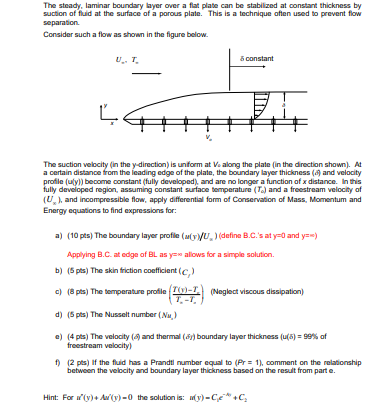Home /
Expert Answers /
Mechanical Engineering /
the-steady-laminar-boundary-layer-over-a-fat-plate-can-be-stabilized-at-constant-thickness-by-suc-pa219
(Solved): The steady, laminar boundary layer over a fat plate can be stabilized at constant thickness by suc ...
The steady, laminar boundary layer over a fat plate can be stabilized at constant thickness by suction of fluid at the surface of a porous plate. This is a technique aften used to prevent flow eeparation. Consider such a flow as shown in the figure below. The suction velocity (in the -direction) is uniorm at along the plate (in the direction shawn). At a certain distance from the ieading edge of the plate, the boundary layer thickness (d) and velocity profie (ufy)) become constant (fully developed), and are no longer a function of distance. In this fully developed region, assuming constant surface temperature ) and a freestream velocity af , and incompressible flow, apply differential form of Conservation of Mass, Momentum and Energy equatons to find expressions for: a) (10 pts) The boundary layer profle (define B.C. 's at and ) Applying B.C. at edge of BL as y=w allows for a simple solution. b) (5 pts) The skin friction coefficient c) (8 pts) The temperature protile (Neglect viscous dissipation) d) (5 pts) The Nusselt number ( e) (4 pts) The velocity ( ) and thermal ( boundary layer thickness (u(s) = ggw of freestream velocity) f) (2 pts) if the fluid has a Prandtl number equal to (Fr ), comment on the relationship between the velocity and boundary layer thickness based on the result from part e. Hint: For the solution is:
Expert Answer
a) The differential equation of conservation of momentum in the y-direction for a steady, incompressible, laminar boundary layer flow over a flat plat
